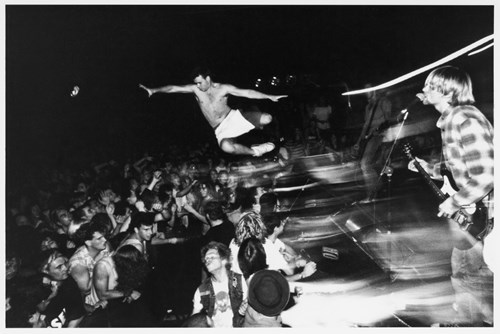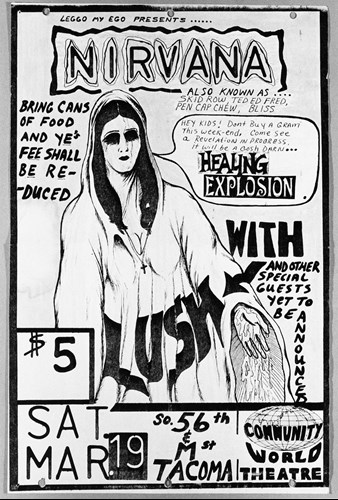Kurt Told Me: Michael Azerrad on Nirvana

The Amplified Come as You Are: The Story of Nirvana by Michael Azerrad, published by HarperOne, an imprint of HarperCollins Publishers, is on sale October 24, 2023.
Michael Azerrad is a rock journalist, author, and drummer. His writing has appeared in The New York Times, Rolling Stone, Mojo, Spin, and The New Yorker. He frequently appears on television as a commentator on rock music and was most recently the editor in chief of Talkhouse. He is the author of the books Come as You Are: The Story of Nirvana, and Our Band Could Be Your Life: Scenes from the American Indie Underground 1981–1991.
Q: You added 115k+ words of new information to this 30th anniversary edition, The Amplified Come as You Are: The Story of Nirvana. Why did you feel that 2023 was the right time to publish this version?
It just worked out that way. At the start of the pandemic I thought I'd get down some thoughts about a few specific things in Come as You Are: The Story of Nirvana. Maybe post them on my blog or something. So I wrote them down, and it was satisfying to get that stuff off my chest. But then I turned to page one of the book to see if I had anything to say about what was there, too, and I did, so I wrote about that. Then I turned to page two, and I definitely had something to say about that! And I just kept going. There was so much to say because the Nirvana phenomenon touched on so many things: popular culture, politics, social movements, the music business, drugs, generational shifts, and so on. Two years later, I'd gone through Come as You Are from beginning to end, and HarperOne said they'd publish it. It takes a long time to publish a book, and 2023 is when everything was finally ready.
Q: You spent a lot of time with the members of Nirvana and their inner circle. Can you describe the dynamics between the band members?
First and foremost, Kurt [Cobain] called the shots. He decided on cover art, T-shirt designs, producers and mixers. He wrote the band's early bios and was the focus of most interviews. Anybody who didn't grasp that didn't last very long in the band. And whether it was his palpable charisma or just the fact that he was the leader, Kurt's mood—and it varied widely—really affected the vibe of any room.
But the band was founded on Kurt and Krist [Novoselic]'s friendship, and Krist also had a lot to do with the band's sensibility. As Dave [Grohl] later told Rolling Stone, “Those two guys, together, totally defined the Nirvana aesthetic. Every quirk, all the strange things that came from Nirvana came from Krist and Kurt.” Krist was also the best technical musician in the group, so he contributed that knowledge, but he did a lot of behind-the-scenes work that kept things functioning, as well, anything from collecting the money after gigs to driving their equipment down to L.A. when they recorded Nevermind—unglamorous, thankless stuff that was nonetheless crucial to the band's continued existence.
In writing The Amplified Come as You Are, I got the sense that Dave took a while to get over feeling like "the new guy." Still, he hit it off with Kurt and Krist right away and bonded with them. He was roommates with Kurt at a very exciting but difficult time when they lived in Olympia, and then just surviving Nirvanamania together brought them closer, a lot like what happened between The Beatles. Dave's professionalism and excellent musicianship helped the band stay on a relatively even keel when things got crazy. Imagine if Dave were a reckless reprobate—the band would have gone right off the rails.

Anarchy reigned at the Motor Sports show. Image credit: Copyright Charles Peterson
Q: Please describe Nirvana's influence on pop culture when they came on the music scene. Is there anything they didn’t impact?!
Kurt told me for the original Come as You Are, "Definitely one of the only things that our band has introduced to rock & roll is gathering that many people in one place to pogo.” And he was serious: For better or worse, Nirvana helped to mainstream punk culture. On the one hand, punk was turned into mall culture, but there were also a few people who picked up on the sensibility and ran with it.
Q: What other pop culture influences were important to the band—movies, books, etc.?
Kurt was a big fan of the 1979 movie Over the Edge, about a bunch of teenagers who smoke pot, drink, and vandalize their town — just like Kurt did! "That [movie] pretty much defined my whole personality," Kurt told me for the original Come as You Are. “It was really cool. Total anarchy.” He borrowed several elements of that movie for the video for "Smells Like Teen Spirit."
As a teen, Kurt really liked two books by S.E. Hinton: The Outsiders (1967), and Rumble Fish (1975). S.E. Hinton pretty much invented the YA novel with The Outsiders, a book that has been a staple of American coming-of-age literature ever since. Kurt surely related to the book’s sensitive, poetry-reading outcast protagonist.
Later, he loved a 1986 Patrick Süskind novel called Perfume. It’s about a maniacal perfume maker in pre-Revolutionary France who has no personal scent, yet has an exceptionally acute sense of smell, both of which alienate him from society. Kurt acknowledged that he had once related to the character: “I felt like that guy a lot," he told me for the original Come as You Are. "I just wanted to be as far away from people as I could — their smells disgust me. The scent of human.” He later based the song "Scentless Apprentice" on that book.
Q: If Nirvana were still making music together today, how do you think their sound would have evolved?
That’s interesting to think about, but it's pure speculation, especially if it's by people who weren't in the band. Although [R.E.M. front man] Michael Stipe, who was going to work with Kurt on new material, told Newsweek not long after Kurt's death that the next Nirvana record was “going to be very quiet and acoustic, with lots of stringed instruments."
One thing we can do is look at how other bands evolved—or didn't evolve—over time. For instance, Talking Heads, The Beatles, Radiohead, and many others started with relatively simple music, then got progressively more sophisticated as they better mastered their instruments, the art and craft of songwriting, and the recording studio. Other bands, like the Ramones, Motorhead, or AC/DC, did pretty much the same thing throughout their careers and made plenty of great records the whole way. And some musicians—Neil Young is a great example—have taken occasional forays into very different kinds of music but always returned to their basic modus operandi. Nirvana could have gone in any of those directions.

Nirvana poster for early show. Image credit: Courtesy of the author.
Want to learn more about Kurt Cobain, Nirvana, and the early Grunge movement in Seattle? Pick up your copy and read all about it in Michael Azerrad’s book, The Amplified Come As You Are: The Story of Nirvana. Available for purchase at the MoPOP gift shop or online here.
